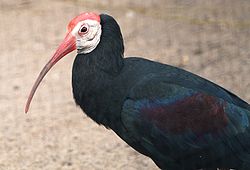Geronticus calvus
| Southern bald ibis | |
|---|---|
 |
|
| Scientific classification | |
| Kingdom: | Animalia |
| Phylum: | Chordata |
| Class: | Aves |
| Order: | Pelecaniformes |
| Family: | Threskiornithidae |
| Subfamily: | Threskionithinae |
| Genus: | Geronticus |
| Species: | G. calvus |
| Binomial name | |
|
Geronticus calvus (Boddaert, 1783) |
|
The southern bald ibis (Geronticus calvus) is a large bird found in open grassland or semi-desert in the mountains of southern Africa.Taxonomically, it is most closely related to its counterpart in the northern regions of Africa, the waldrapp (Geronticus eremita). As a species, it has a very restricted homerange, limited to the southern tips of South Africa in highland and mountainous regions.
This large, glossy, blue-black ibis has an unfeathered red face and head, and a long, decurved red bill. It breeds colonially on and amongst rocks and on cliffs, laying two or three eggs which are incubated for 21 days before hatching. It is a large bird that feeds and roosts in substantial groups. It feeds on insects, small reptiles, rodents and small birds. They do little vocalizing other than occasional gobbling sounds.
The ibises are gregarious long-legged wading birds with long down-curved bills; they form one subfamily of the Threskiornithidae, the other subfamily being the spoonbills. The two Geronticus species differ from other ibises in that they have unfeathered faces and heads, breed on cliffs rather than in trees, and prefer arid habitats to the wetlands used by their relatives. The species is currently listed as vulnerable on the IUCN Red List, however, it is in no immediate danger of extinction.
The southern bald ibis is part of the family, Threskiornithidae, which is composed of birds from the warm temperate and tropical regions of the world, with the exclusion of Oceania. The group is defined by the lack of feathers on their face. This family is composed of the ibises and their close relatives, the spoonbills.
Taxonomically, ibises are categorized as a subfamily named Threskiornithinae. This subfamily contains around 26 species of wading birds with long, thin, down-curved beaks, ranging in size from medium to large. These species rarely have a voice box, and if one is present, the bird only croaks or cackles harshly. Historically, ibises are an ancient group. Fossil records of these birds have been dated back to the Eocene period, 60 million years ago. Human history records also date these birds back 5 000 years.
The southern bald ibis is part of the genus Geronticus, which includes two distinct species. The southern bald ibis (Geronticus calvus) is restricted primarily to the southern regions of Africa whereas its counterpart, the waldrapp (Geronticus eremita) is found in the northern regions of the continent. Both species share common characteristics regardless of their geographic separation. Both species nest on rock cliffs and display distinct breeding behaviours adapted for their particular locations. Similarly, they both show evolutionary adaptations in foraging behaviours due to their dry habitats. The separation between these two species is believed to have occurred relatively recently. This separation, between G. calvus and G. eremita, is believed to have occurred only 335 000 to 1 million years ago.
...
Wikipedia

